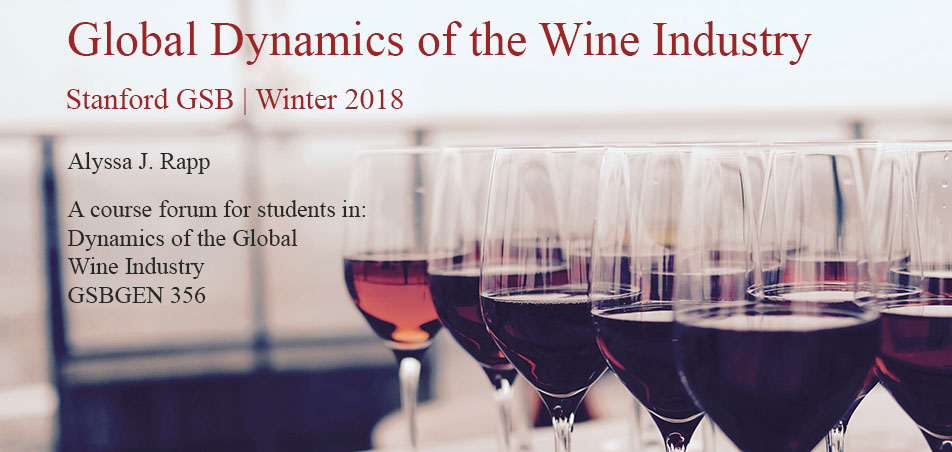Before the experiment, many of us were quite confident that Absolut "tastes better" and is "smoother" than Smirnoff (myself included). As a matter of fact, Absolut's retail price is about 50% more than that of Smirnoff. However, when the class started tasting, we very much disagreed with each other on our perception of the results. In the end, only one student out of 15 gave the correct answer (expected value of a correct random guess is 1/8 - we did worse than guessing randomly).
The purpose of the experiment was to show us the power of branding and consumer perception. That made me reflect on the wine market as well - how does branding affect our perception of the quality of the wine? Obviously, it's easy to tell the difference between a $5 bottle and a $100 one, but how do consumers differentiate the difference between a) a $100 bottle and a $500 bottle, and b) a $7 bottle and a $10 bottle?
It's interesting to further reflect on the concept of branding in wine. What does it exactly mean? We learned about 5 ways of brand association in class: Sincerity, Excitement, Competence, Sophistication, and Ruggedness.
- Sincerity: to be "sincere" in wine probably most closely means to be honest. Label the wines in a consumer-friendly way, and call it what it is. I think the Foot of the Bed Cellars that the Wine Circle introduced to us in a tasting event is a good example of it - unassuming design and super easy to read labels.
- Excitement: this has much to do with the design and labeling of the bottle. A quite effective way to introduce excitement is through complete subversion of the traditional image of wine: to turn the elegant, exclusive, mature image of wine into a unvarnished, embracing, and young one. The success of Apothic wines could be a good example of using excitement to capture the younger drinkers.
- Competence: winemakers can also achieve brand recognition through proven competence. I think Kirkland Signature can be a "pure play" competence brand: consumers really don't get any utilities from its brand except for knowing that it is a drinkable wine at a very affordable price.
- Sophistication: this is likely the most widely used strategy in wine branding, from the Burgundy 1er Crus to the $100+ bottles in Napa. When consumers purchase a sophisticated brand, they experience two levels of enjoyment: one from the self-realization of their capability to appreciate sophistication, and one from the expected recognition from others of the consumer's status. Drinking a bottle of Opus One is not that different from wearing an Hermes.
- Ruggedness: this could be an interesting one... Surprisingly, winemakers can associate their bottles with ruggedness yet drinkable. Consider 19 Crimes - it sells wine through association with the earliest prisoners sent to Australia from the UK. The image of untamed, brave explorers of the new world strangely speaks to wine drinkers - maybe it's in wine where people are searching for their alter ego.
Foot of the Bed Cellars - Sonoma Valley Syrah:

Apothic wines:

Kirkland Signature

Petrus, retails at $3,500+

19 Crimes:


I had such a blast from the blast reading this blogpost! I remember doing that same vodka experiment last year in marketing class. (I was the one person in my class that got all three right...#thankscollege) haha.
ReplyDeleteBut this made me think about other factors that can influence our perceived quality of the wine. I came across a Forbes blog post that hit on this exact point:
"I swiftly concluded that the first wine was an unoaked Chardonnay and the second was a Sauvignon Blanc, easy peasy. Much to my mortification I was dead wrong...The proprietor chuckled and informed his room of bright-eyed ambitious wine journalists that the wines were actually the same wine; one was just warmer than the other. "
Temperature, drinking vessel, food, etc also influence our perceived value of a wine. This made me wonder if branding, price, or label are able to outweigh other external factors.
Lastly, I wanted to challenge the idea that it's "obviously, it's easy to tell the difference between a $5 bottle and a $100" bottle of wine. There have been numerous blind taste tests that have proven that the odds are 50/50 with identifying correctly, and a more anecdotal example was laid out in a Freakanomics podcast.
Levitt took two expensive vintages from the cellar along with the cheapest bottle he could find made from the same grape (about one-tenth the price of the other bottles), and conducted a wine tasting between four cups: Two held the same expensive wine, one held the other expensive wine, and the last held the cheap wine.
Levitt detailed the results on the Freakonomics blog:
"The results could not have been better for me. There was no significant difference in the rating across the four wines; the cheap wine did just as well as the expensive ones. Even more remarkable, for a given drinker, there was more variation in the rankings they gave to the two samples drawn from the same bottle than there was between any other two samples. Not only did they like the cheap wine as much as the expensive one, they were not even internally consistent in their assessments."
I find the 5 brand associations fascinating. Eric, I'm curious if your marketing class has shared more examples in each of these 5 dimensions. Would be great to chat more offline
ReplyDelete